Finally, Champions League football has returned to the football fans with many interesting clashes waiting for us. One of the matches that caught the eye was between Inter Milan and Slavia Prague at the Giuseppe Meazza. The Czech First Division champions travelled to Italy with high confidence, as they remain unbeaten in their domestic league with only two goals conceded.
Antonio Conte’s side had an summer overhaul, with many arrivals and departures to the Inter squad. After a good pre-season campaign, their form carried on into the season, having won the first three games of the Serie A season. This gave them a lot of momentum going into their Champions League match, but they had a difficult first half against Slavia. Things improved in the second half, but a goal from Peter Olayinka put the Czech club in front. Inside stoppage time, substitute Nicolò Barella found his way to the goal to secure a valuable point for Inter.
This tactical analysis will provide an analysis of the draw between Inter Milan and Slavia Prague. Meanwhile, using statistics, we will point out the standout tactical points in both Inter’s tactics and Slavia’s tactics.
Lineups
Conte went for the 3-5-2 formation with no fresh injury concerns from their win against Cagliari last weekend. After making an appearance on the bench, Roberto Gagliardini was chosen to fill Matías Vecino’s place in the lineup and completed the midfield line that already consisted of Marcelo Brozović and Stefano Sensi. Alexis Sánchez and Matteo Politano were expected to lead the line alongside Romelu Lukaku but Lautaro Martínez was the eventual choice for the Italian manager.
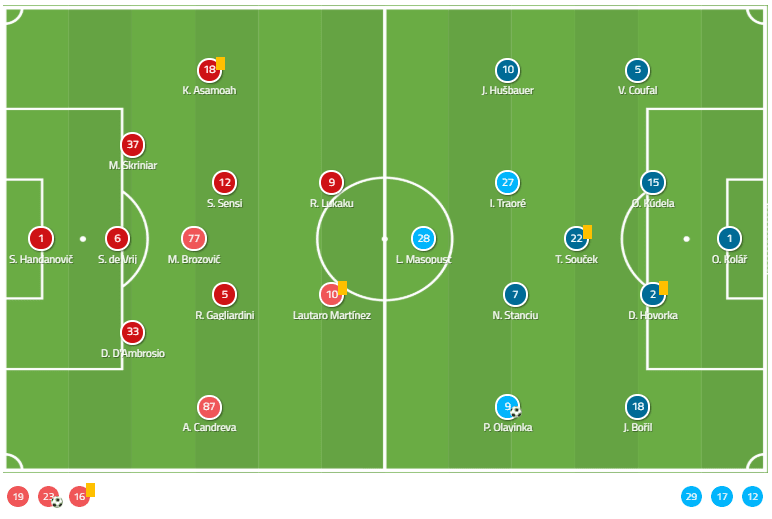
The visitors lined up in a 4-1-4-1 formation with the return of goalkeeper Ondrej Kolář and centre-back David Hovorka. Veteran striker Milan Škoda was registered as a substitute, while Lukáš Masopust led Slavia’s line. Behind him were two central midfielders in Nicolae Stanciu and Ibrahima Traoré, whilst Peter Olayinka and Josef Hušbauer provided the width.
Slavia’s style of play
Despite being the underdogs, Slavia didn’t show any signs of lowering their mentality. Instead, they employed a high pressing strategy in which the striker and the midfielders pushed into the opposite half. They attempted to win the ball back high up the pitch to create a counter-attack and hit Inter on a quick break.
Their man-oriented press allowed Slavia to match the opponent’s number and prevented them from winning numerical superiority. In this case, each player would be responsible for one of Inter’s players as they aimed to disrupt their build-up.
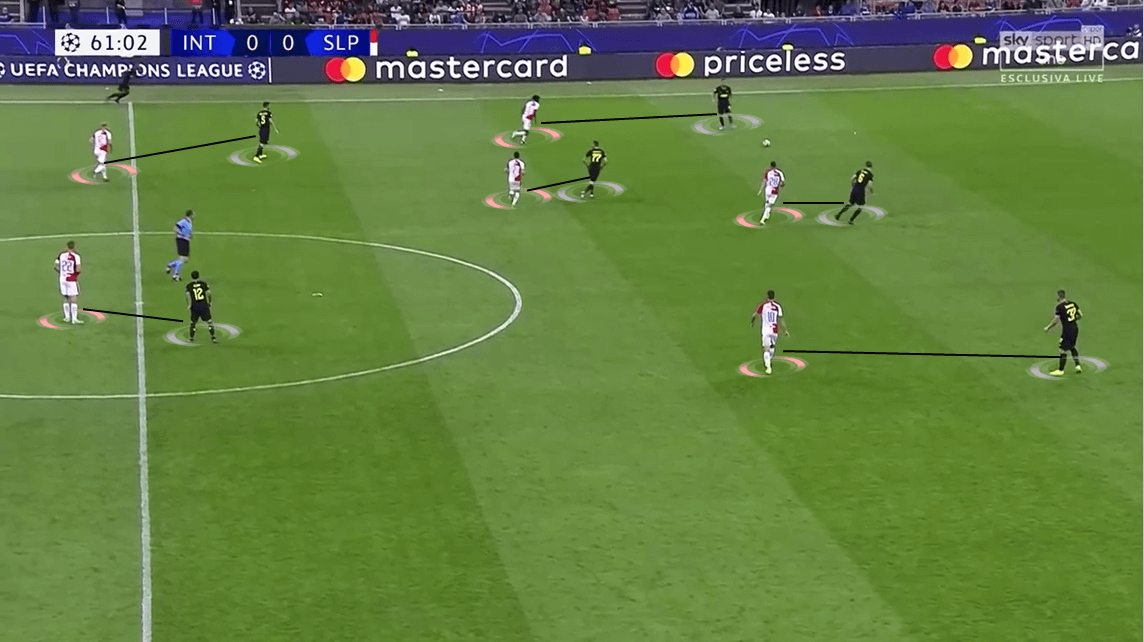
To deal with Inter’s back-three, usually, two wide players pushed up along with the lone striker to mark them up. Amongst them was Stanciu who was tasked with following the midfielder who dropped deep and provided a passing option. Especially when the player near one of them received the ball, they would aggressively put pressure on the ball carrier to force a heavy touch.
Supporting them were Tomáš Souček and Traoré, as they prevented Inter central midfielders from approaching the four-man build-up. By doing so, the away side eliminated two possible passing options that could offer to bring the ball out of defence and progress it up the pitch.
On several occasions, Slavia even prevented short distributions from the goalkeeper by pushing one of their players up. They narrowed the space surrounding Handanovič and forced the Slovenian goalkeeper to make a heavy touch. But as good as their press was, it didn’t bring them many counter-attacks inside Inter’s half. Since the home side constantly used short combinations to bypass the press, they were able to recycle possession while still building most of their attacks.
Their high pressing strategy also brought them a setback. During the process, they had to commit players up the pitch to counter against Inter’s numbers. This left the defensive line vulnerable when dealing against the Inter attackers, as they only had four players inside the middle third. In case the home side circulated the ball away from the press, most of their midfielders were still caught off in their positions. Then, Inter were able to win the superiority in numbers to make passes in between the gaps of Slavia defenders. The Italian club constantly capitalised this to create chances for themselves during both halves transitioning period.
On the ball, they had the tendency of keeping the ball and created attacks from both flanks. Firstly, Slavia usually put an emphasis on playing out from their backline of four defenders. Among their back-four were two centre-backs who were comfortable on the ball in Hovorka and Ondřej Kúdela. They would receive the ball from the goalkeeper and combined with Souček to create a three-man build-up on the edge of the middle third. In total, the central defender duo registered 59 passes among them and completed 53 of them.
Meanwhile, two full-backs moved flexibly down their wings to support the build-up and link up with the attackers. As Inter pressed high up the pitch, their movements became crucial because they could act as a potential receiver to help the centre-back relieve the pressure from the opponent. But again, their strategy failed several times in the game since Inter pressed aggressively and didn’t allow Slavia defenders to have time and space to aim their pass.
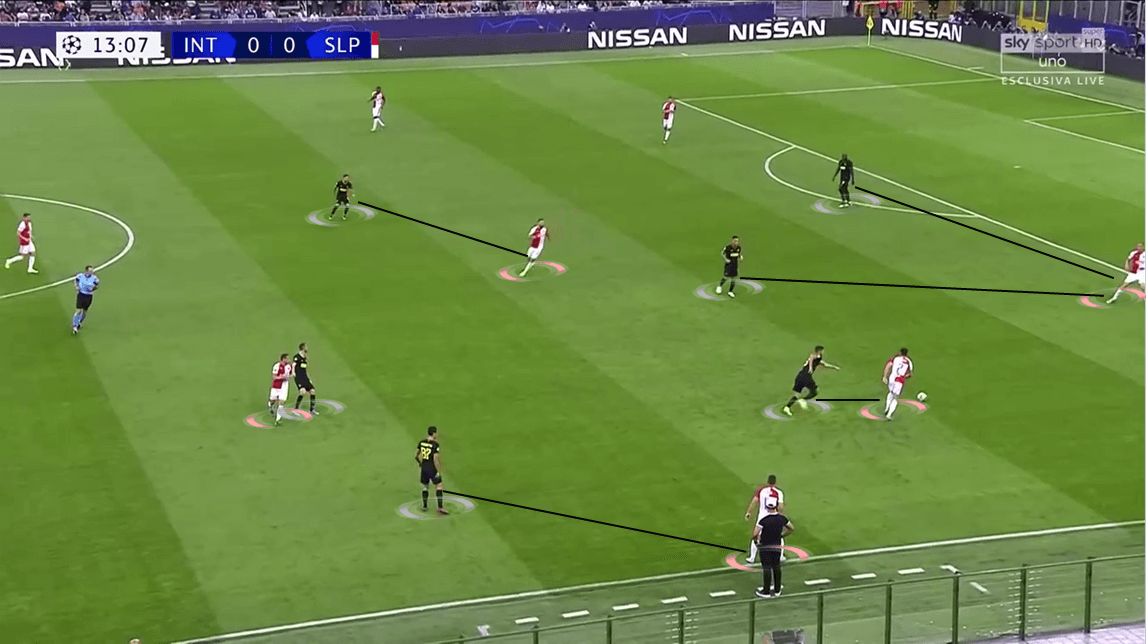
Secondly, they were a wing-oriented team using the overlapping runs from both Jan Bořil and Vladimír Coufal. As mentioned, these two would position themselves high up the pitch depending on the situation and wait to receive the ball from their teammates. Along with the central midfielders and wingers, they attempted to stretch Inter’s defensive structure to create spaces centrally. It doesn’t come as a surprise to know that seventeen of their positional attacks came from both flanks, with nine from the left-hand side and eight from the opposite wing.
Eventually, one of their attacks was converted into the opening goal of the game. From an attack that was executed on the right-wing, substitute Jaroslav Zelený found Stanciu with a pass which headed towards the final third. The Romanian veteran continued his run towards the edge of the box where he laid the ball towards Olayinka. He then noticed Zelený was approaching the free space and passed it to him. His shot was saved but Olayinka was there to make a rebound.
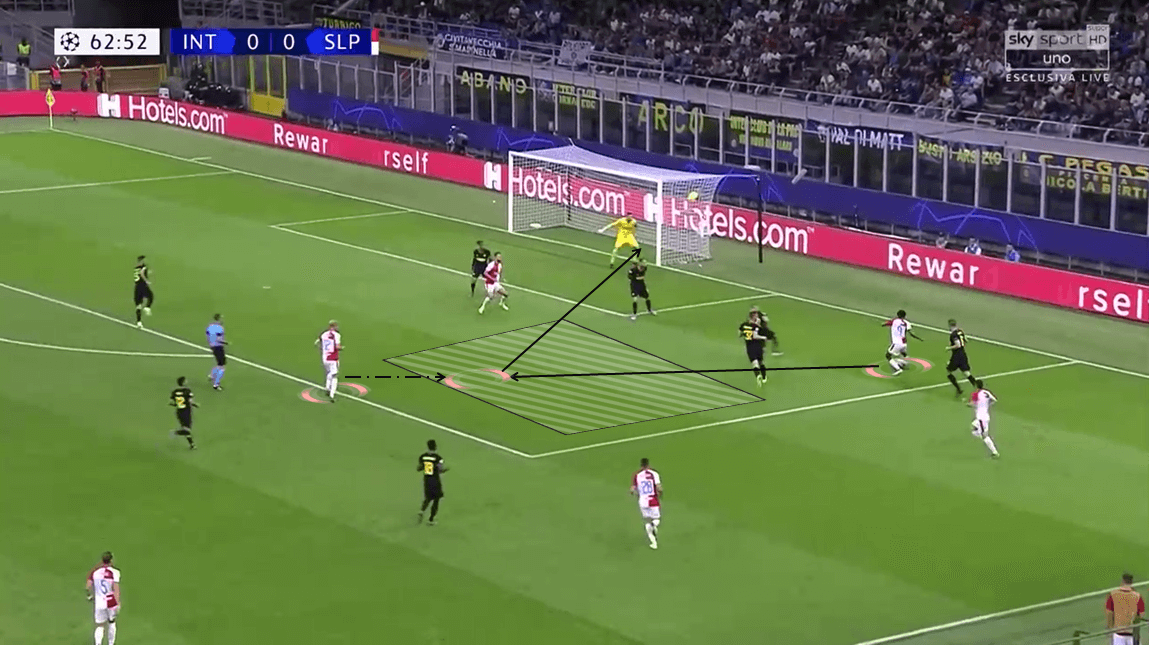
In general, it’s fair to say that Slavia had had a quite decent game in terms of creating chances. They had most of their chances inside the box on target but Handanovič was solid in goal. Another noticeable thing was although they kept their shots on goal, they weren’t clinical enough. That could be one of the reasons that led to the first half ending in a stalemate.
But, as time progressed, they improved the quality of their chances in the second half and most of them reached a rating of over 0.1. Still, they ended up with a draw which they could consider as a success in a match where they faced a lot of pressure from Inter.
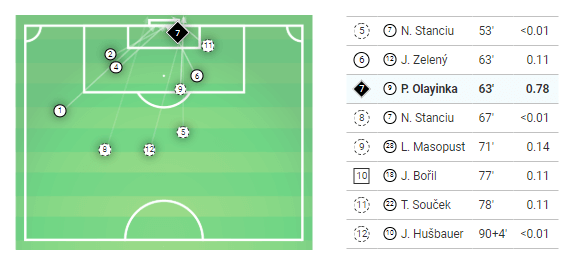
Inter’s style of play
Inter, on the other hand, might be wondering why they couldn’t secure three points at home. Everything went according to their plan, especially with the build-up process. The home side entered the match with a back-three, positioned Danilo D’Ambrosio in a more central position. This created a three-man build-up inside their half and allowed them to circulate the ball more efficiently.
At times, either one of the central midfielders, or even both, dropped deep to provide passing options. Usually, the one who played in a deeper role, Brozović would move close to the centre-backs and offered to bring the ball out of defence. Gagliardini and Sensi stayed quite higher but also maintained sufficient distance to keep the risk of the passes as low as possible. With at least two passing triangles created among the defenders and Brozović along with a few created with the central midfielders, they managed to bypass Slavia’s press and get the ball towards the attackers.
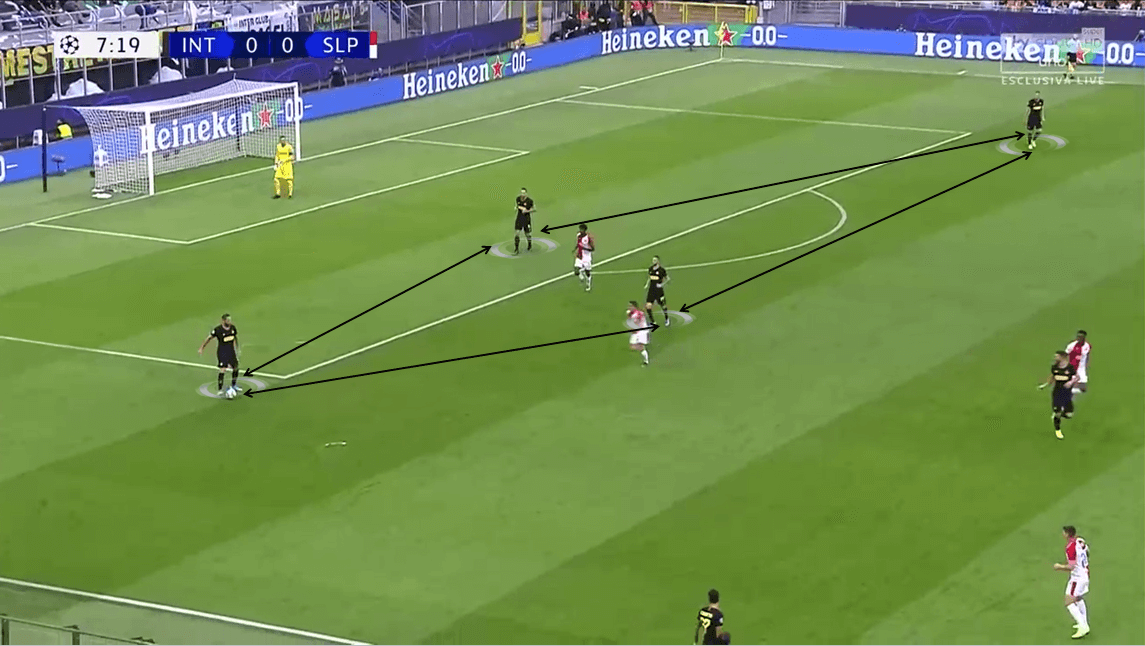
On several occasions where they pinned Slavia’s defensive shape down, the centre-backs had the option of dribbling with the ball. It’s not unusual to see D’Ambrosio dribbling as he is a natural wing-back, but both Skřiniar and de Vrij also attempted this quite often. They would head towards the opposite half and allowed the midfielders to position themselves in pockets of space to receive the ball.
Another option that they had when reaching the half was making a long ball towards the striker. In the role of a target man, Romelu Lukaku would drop deeper than his original position to attract the attention of defenders. This created space behind their backs for Martínez to move in and received the pass from the centre-backs. The Belgian striker could also pick up the ball by himself and use his physicality to shield the ball for his teammates.
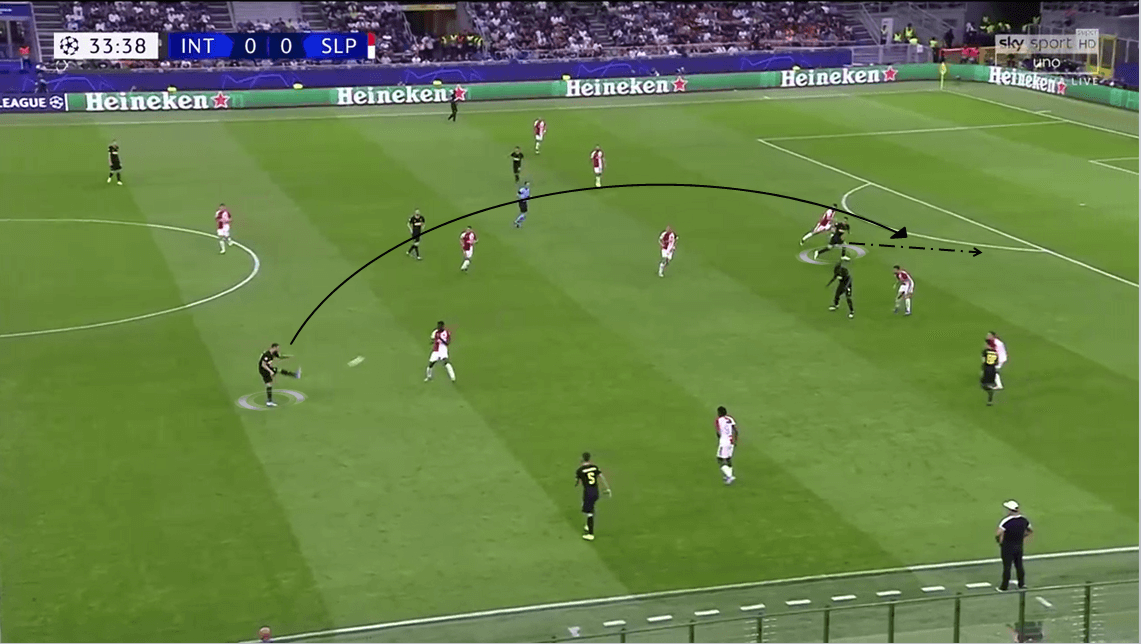
It’s also worth noticing that the combination between the centre-backs was quite clear, as shown on Inter’s passing map. Among themselves, they created 66 links with de Vrij topping the link table with three of them. As the central centre-back, he usually found himself with the ball and had many passing options around him. It helped the Dutch defender to register a high-efficiency rate for his passes (which stood at 90%) and he became a key part in the team’s build-up.
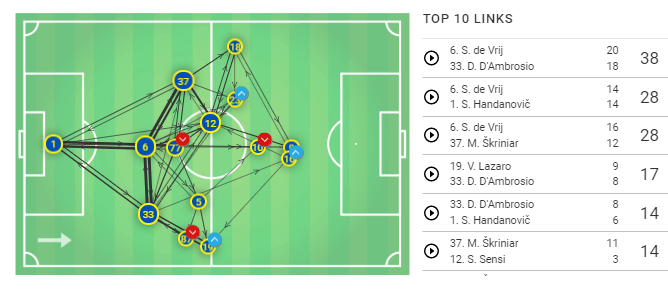
They also shaped up in a clear 3-5-2 formation during their build-up process and even in attacks. But strangely, Inter would defend with a 4-4-2 when they didn’t hold possession. Candreva moved from his right wing-back position to join up with the midfielders to create the second defensive line in front of their box. Their responsibility was to combine with the strikers and attempting to press the ball carrier and his available passing options. This happened on several occasions where Slavia circulated the ball outside of the shape. The former Lazio midfielder still formed a back-five along with his colleagues for the majority of the time to defend against the opposition’s attackers.
Inter’s defensive line had the responsibility of defending zone 14 and at times, stretched out to occupy the wide areas. This prevented the Czech club from distributing the ball wide and approached the box through crosses. Meanwhile, they also moved flexibly behind the midfield line to cover up gaps in between the lines and prevented Slavia attackers from capitalising it.
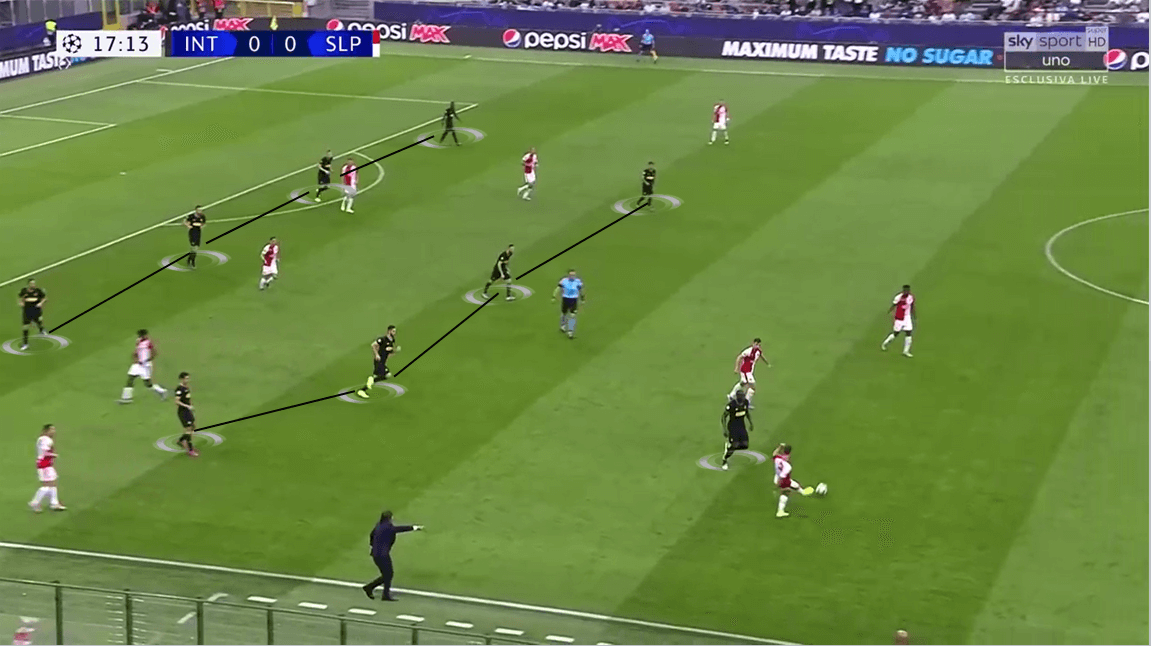
When the away side did move the ball wide, the nearest players, usually the wing-back, two central midfielders and a centre-back, would create an overload around the ball carrier. They used the byline as the fifth pressing player to force the opponent to make a misplaced pass. Then, either one of them picked it up and started a quick counter-attack. Inter employed this strategy constantly throughout the match and limited the threat that came from Slavia’s wing-attacks.
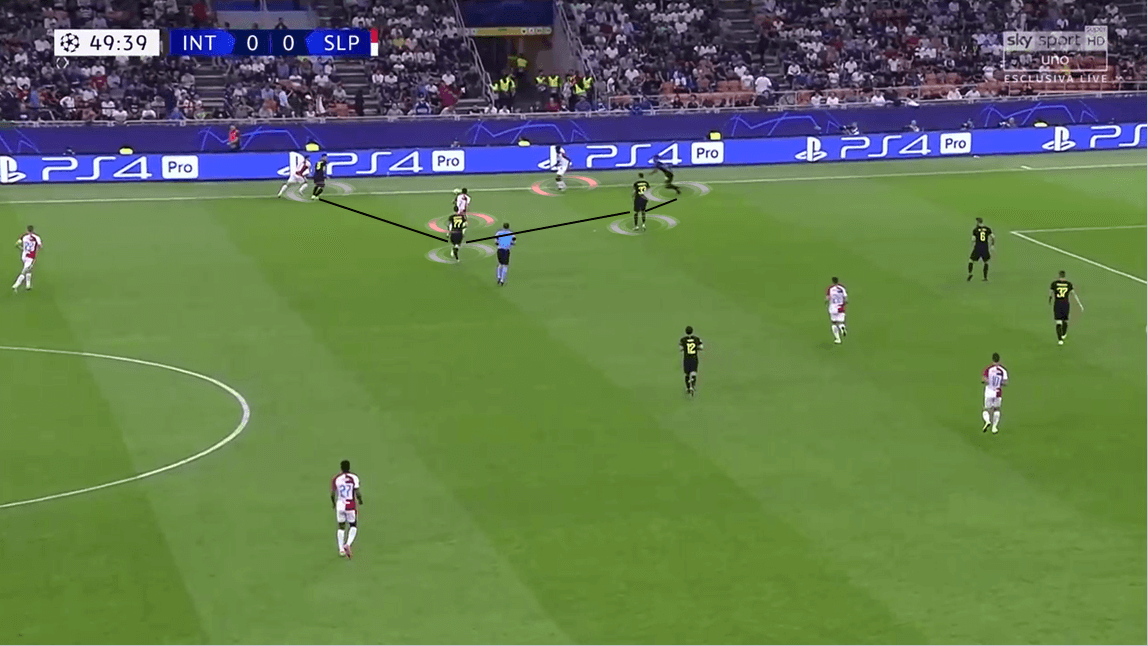
But, as good as it seemed to be, there was a setback that the Italian club didn’t solve. In the shot below, Slavia also started their attack from the left-wing and the ball carrier was dribbling the ball into the central area. Inter kept their strategy of committing players into that area for overload and maintained it until that player lost the ball. They moved along into the central area while creating a cage around him.
With so many players surrounded the ball carrier, they left gaps in between their backs which weren’t vacated, and allowed Slavia attackers to move in. Although the outside centre-back could follow his run and prevented him from reaching the box, several of the opposition’s attackers had the pace to beat him and was at the end to receive the pass. This could lead to dangerous chances in which Handanovič had to be in 1v1 situations. Fortunately for Inter, none of those occasions resulted in a goal, but they need to be aware of that problem to fix for the upcoming matches.
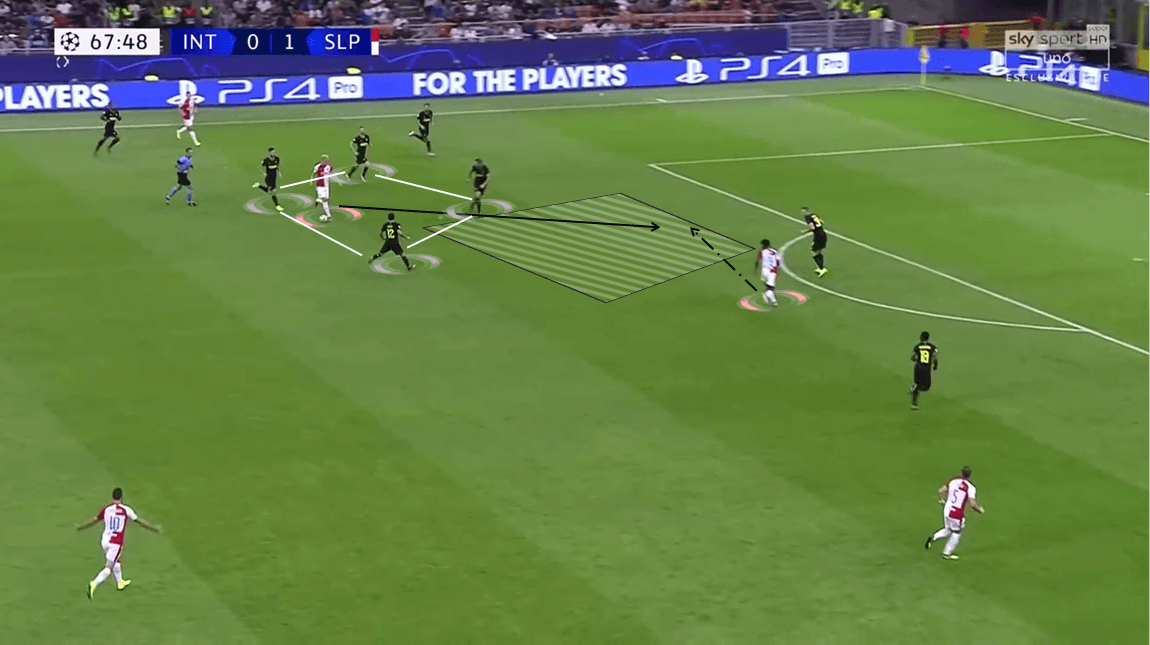
They were good in terms of defence, but it was a different story at the other end of the pitch. Inter had a fair few chances inside the first half, with Lukaku (0.53 xG) and D’Ambrosio (0.37 xG) coming close with two highly-rated chances. Martínez also had a chance to hit the target at the turn of both halves, but he wasn’t able to give Inter the lead.
There was one noticeable thing on the graph, which was the number of chances being created outside of the box. Inter relied on long shots quite often and although two of them found the target, it wasn’t enough to bring them what they need. And it had to be the substitute Nicolò Barella to save the day for the club at the 90’+2 minute.
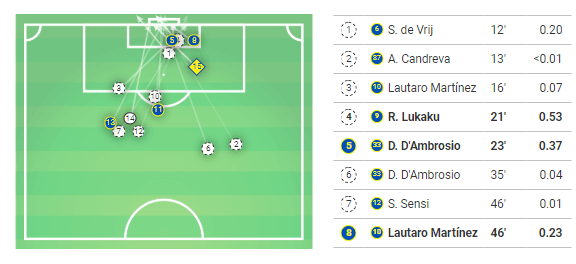
Earlier, Sensi’s free-kick rattled the bar and deflected into the play. While most of Inter players were still struggling to identify where the ball would drop, Barella quickly noticed it and positioned himself perfectly to pick it up. There, his first-touch shot hit the ground and Kolař had no chance to save it since his sight was blocked by a crowded area just in front of the 6-yard box.
Slavia could have stopped this goal by instructing another player to step out and cover for Stanciu. He was the nearest player to him but wasn’t able to block the shot, as the former Cagliari midfielder drove his shot into the ground and it bounced away from Stanciu’s reach.
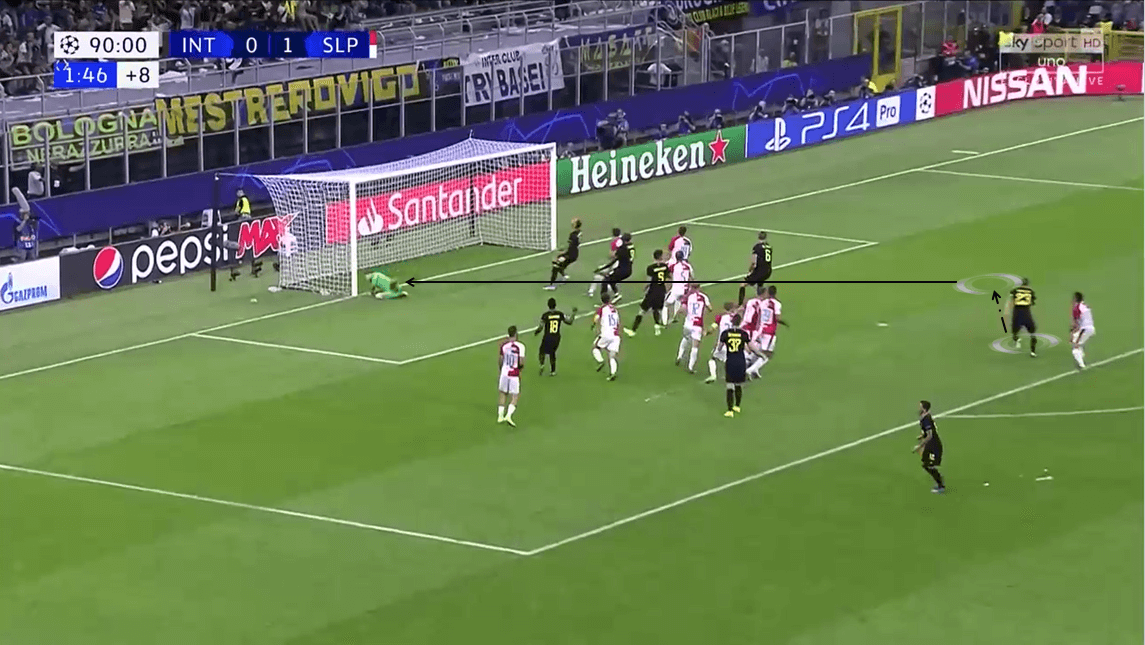
Conclusion
There are many things that we could point out about this match from both teams’ perspectives. They could have improved in many aspects and there are things that they have done well. But, a draw is well-truly deserved for both sides on a day that Inter and Slavia both faced certain struggles from their opponent.
The Czech club were the underdog team but forced Inter to play in a negative style on several occasions and even secured the opening goal. But they didn’t have the quality and the player who shined in the decisive minutes, which Inter had, to seal the game. It isn’t a bad start for these teams as they return to their domestic leagues, aiming to keep their unbeaten run.

If you love tactical analysis, then you’ll love the digital magazines from totalfootballanalysis.com – a guaranteed 100+ pages of pure tactical analysis covering topics from the Premier League, Serie A, La Liga, Bundesliga and many, many more. Buy your copy of the August issue for just ₤4.99 here




Comments